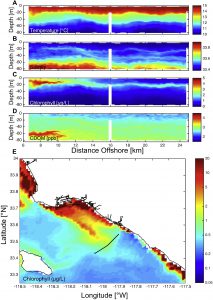A recent comprehensive review in the journal Harmful Algae documents over a decade of monitoring, research, and findings related to the diatom Pseudo-nitzschia and its toxin, domoic acid, off Southern California. NCCOS is a major supporter of Pseudo-nitzschia research on the West Coast providing over $11M for research since 2007. NCCOS competitively funded harmful algal bloom (HAB) projects have advanced the ecological understanding of Pseudo-nitzschia along the U.S. West Coast and contributed to this review.

Along the West Coast from Alaska to California, Pseudo-nitzschia species bloom in spring and summer, sometimes producing domoic acid, which causes Amnesic Shellfish Poisoning in humans. Over the last 15-20 years, toxin-producing Pseudo-nitzschia blooms increasingly threaten wildlife and shellfisheries along the West Coast, especially in the Southern California Bight region.
In the review, lead author Jayme Smith (USC-Los Angeles) and co-authors summarize 15 years of Pseudo-nitzschia sampling and domoic acid-related wildlife mortality events. It also discusses the role of nutrients, river discharge, runoff, upwelling, water temperature, inter-annual variability, seasonality, and decadal drivers on Pseudo-nitzschia blooms and toxicity.
The authors found that blooms and toxicity exhibit strong variability among years and seasons with toxins appearing mostly in the spring. Timing of blooms differed in north and central California counties compared with southern counties, depending on water temperatures, and not all upwelling events produced blooms. Decadal oceanographic patterns in the region such as the Pacific Decadal Oscillation (PDO), North Pacific Gyre Oscillation (NPGO), and the El Niño Southern Oscillation (ENSO), have more subtle influences. Increasing water temperatures from climate change in Southern California may exceed optimal ranges for Pseudo-nitzschia growth and actually decrease the potential for future toxic events, though the authors caution that warm-adapted Pseudo-nitzschia species may evolve to accommodate changing water temperatures.
The study clearly demonstrates the need for additional research on Pseudo-nitzschia ecology and bloom toxicity in Southern California, especially the role of offshore toxic bloom events and their ability to seed coastal blooms.
Over the last 20 years, NCCOS has funded numerous research, monitoring, and event response projects involving Pseudo-nitzschia and domoic acid. NCCOS also supports numerous regional HAB monitoring programs along the West Coast, including the Alaska HAB Network (AHAB), California Harmful Algal Bloom Monitoring and Alert Program (CalHABMAP), California Harmful Algae Risk Mapping (C-HARM), the Olympic Region Harmful Algal Bloom Partnership (ORHAB), the SoundToxins cooperative partnership in Washington, the California HAB Bulletin, and the Pacific Northwest HAB Bulletin.
Citation: Smith, Jayme, Paige Connell, Richard H. Evans, Alyssa G. Gellene, Meredith D. A. Howard, Burton H. Jones, Susan Kaveggia, Lauren Palmer, Astrid Schnetzer, Bridget N. Seegers, Erica L. Seubert, Avery O. Tatters, and David A. Caron. 2018. A decade and a half of Pseudo-nitzschia spp. and domoic acid along the coast of southern California. Harmful Algae 79: 87-104. https://doi.org/10.1016/j.hal.2018.07.007
